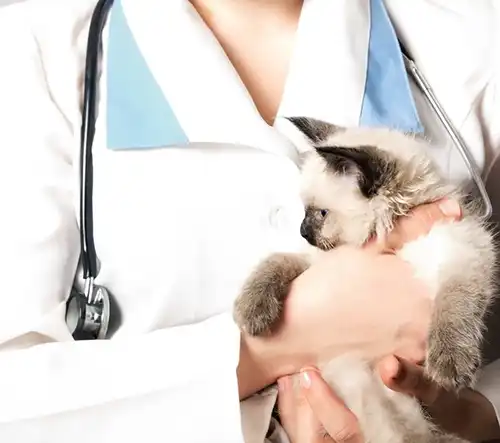There is a hidden danger lurking in numerous lakes and ponds around the Marin County, CA area. Cyanobacteria, also referred to as blue-green algae, is a bacteria species that flourishes in warm water environments. The toxin it emits can be extremely hazardous and even fatal to both humans and pets. This is important information for all pet owners to be aware of, especially those who bring their dogs swimming in freshwater. Continue reading to gain valuable insight from a local Marin County, CA veterinarian about this hazardous toxin.
What Exactly Is Blue-Green Algae?
This type of algae is especially concerning due to its production of a specific type of toxin. Blooms can happen any time the average water temperature exceeds 75 degrees, as this is when bodies of water become abundant in nutrients. The summer months, especially around and just after the dog days of summer, can be particularly dangerous. Blue-green algae is also more commonly found in shallower lakes and ponds. Under the right circumstances, blooms have the potential to grow rapidly.
How Dangerous Is Blue-Green Algae?
Blue-green algae poses a significant threat to the health and safety of both humans and pets. Exposure can cause a range of unpleasant symptoms, including diarrhea, nausea, vomiting, skin rashes, eye and throat irritation, and respiratory distress. Additionally, it may result in severe neurological issues or even liver failure. Exposure to or ingestion of significant quantities of the algae can result in fatality. Unfortunately, there is currently no antidote available.
Animals such as dogs and livestock are especially vulnerable to the dangers of drinking contaminated water, as they lack the knowledge to avoid it and may consume a significant amount before intervention is possible.
Is Swimming In Blue-Green Algae Safe?
The answer to this is a resounding ‘no’. Especially since blooms can often go unnoticed. It is important to exercise caution and thoroughly research local water sources, even if a lake or pond appears to be safe. Stick to areas that have been cleared and are designated as safe for swimming.
How Can I Determine The Presence Of Blue-Green Algae?
Typically, it’s pretty easy to spot blue-green algae blooms based on their appearance and odor. Cyanobacteria is commonly referred to as blue-green algae due to its distinct coloration. The blooms often resemble the color and consistency of pea soup or green paint. They also emit an unpleasant, swampy smell.
However, appearance alone is not enough to make a judgment, as it may be difficult to notice smaller blooms.
What Signs Or Symptoms Indicate Exposure?
It’s always important to closely monitor your pet and watch for any signs of trouble. In this case, the signs you would want to look for include panting, respiratory problems, vomiting, diarrhea, dizziness/disorientation, and excessive drooling. Seizures are another warning sign. If you notice any of these red flags in your furry friend, contact your Marin County, CA vet or an urgent care clinic immediately.
As mentioned above, there is no antidote for blue-green algae exposure. That said, proper supportive care can make a huge difference. Ask your Marin County, CA veterinarian for more information.
How Is Blue-Green Algae Ingested?
Drinking contaminated water is the most common way dogs get sick from blue-green algae, but it isn’t the only way. People and pets can also ingest the toxins through their skin or by breathing in water droplets or vapor. That means contamination can occur by swimming, floating, boating, tubing, or water skiing.
Because many dogs enjoy splashing around, they can get sick by being immersed in water. They could also be further exposed by licking the cyanobacteria off their fur after the fact.
How Can I Know If A Body of Water Is Safe For Fido?
If you notice that telltale green scum on top of the water or smell a swampy odor, then you should assume the water is unsafe. However, as mentioned above, the bloom may not always be easy to spot or smell. Look for posted signs, as many local governments will put up notices when blue-green algae blooms are confirmed.
You can also consult the HAB (Harmful Algae Blooms) map, which can be found here. This site provides updates on blue-green algae blooms for every state.
What Should I Do If My Pet Comes Into Contact With Cyanobacteria?
We always recommend giving your dog a rinse after swimming, regardless of whether it’s in a pool, lake, or beach. Ensuring that sand, salt, chemicals, and bacteria are removed from his fur and skin is crucial.
If you believe your pet has been exposed to or has ingested blue-green algae, you should also contact your Marin County, CA vet immediately for further instruction.
How Long Do Blue Green Algae Blooms Last?
Individual blooms typically only last a week or two. However, when conditions are ripe, they may immediately be replaced by more. Generally speaking, affected bodies of water may remain contaminated for weeks or even months. This usually occurs between mid-to-late summer and early fall.
Will Boiling Water Get Rid Of Blue-Green Algae?
Unfortunately, no. It’s important to understand this, especially if you enjoy camping with your furry friend and frequently need to boil water from natural sources. While boiling is effective at eliminating live bacteria and microorganisms, it does not eliminate cyanobacterial toxins.
What Else Can I Do To Keep Fido Safe At The Lake?
There are other potential threats that can be found in lakes, aside from cyanobacteria. Swimming can be a source of enjoyment for Fido, but it’s important to be aware of the potential dangers it poses. Some dogs simply aren’t cut out for it. For instance, if your dog is a brachycephalic breed or struggles with mobility, it’s best for them to enjoy water play in a kiddie pool.
You should also be cautious with very small dogs around water as they can easily find themselves in over their heads in even just a few inches. If you’re not sure whether swimming is appropriate for your dog, it’s best to consult your Marin County, CA veterinarian.
If your canine pal doesn’t know how to swim, take the time to teach him. Introduce a pup to water with caution and care. Offer your support and encouragement as he navigates the learning process, frequently rewarding him for his efforts.
Always ensure your dog is supervised when near water, even if Fido is a strong swimmer. Be mindful of the places you take him. In addition to avoiding areas with blue-green algae blooms, you should also steer clear of bodies of water that feature steep drops, heavy wakes, or strong currents. Red tides can also pose a threat to beachgoing pups during the summer season.
It’s important for your four-legged friend to have a good grasp of basic obedience commands like Sit, Stay, and Come. This is crucial, as it can prevent your dog from venturing into a hazardous area. It’s also a good idea to teach your dog where the stairs are when taking them to a pool.
Lastly, it’s critical that you don’t allow your dog to drink water from lakes, ponds, or puddles. Aside from the potential threat of cyanobacteria, Fido may also be at risk of contracting parasites like Giardia.
In conclusion, during the summer season, many lakes and ponds are plagued by the presence of blue-green algae, also known as cyanobacteria, which is highly toxic. This poses a significant risk to people, pets, and livestock. Indeed, exposure can be life-threatening for our furry companions. Pet owners must be aware of the potential dangers and learn how to recognize and prevent exposure to blooms.
Schedule an Appointment at Our Marin County, CA Pet Hospital
Is your dog in need of a check-up, vaccination update, or parasite prevention? Don’t hesitate to reach out to us, your trusted Marin County, CA animal clinic, any time!







!Social Media Icons